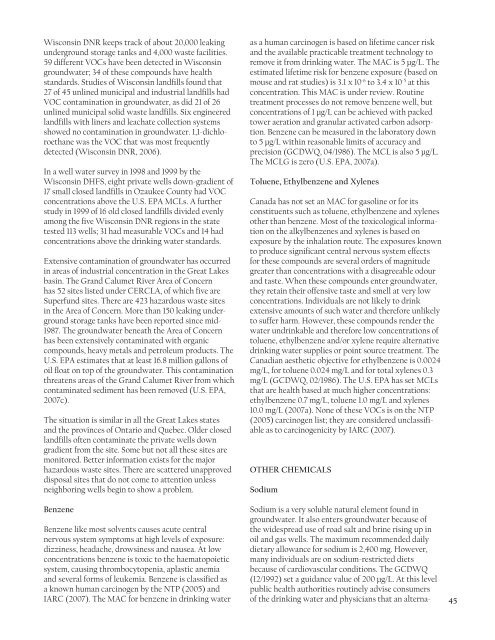Groundwater in the Great Lakes Basin
Groundwater in the Great Lakes Basin
Groundwater in the Great Lakes Basin
You also want an ePaper? Increase the reach of your titles
YUMPU automatically turns print PDFs into web optimized ePapers that Google loves.
Wiscons<strong>in</strong> DNR keeps track of about 20,000 leak<strong>in</strong>g<br />
underground storage tanks and 4,000 waste facilities.<br />
59 different VOCs have been detected <strong>in</strong> Wiscons<strong>in</strong><br />
groundwater; 34 of <strong>the</strong>se compounds have health<br />
standards. Studies of Wiscons<strong>in</strong> landfills found that<br />
27 of 45 unl<strong>in</strong>ed municipal and <strong>in</strong>dustrial landfills had<br />
VOC contam<strong>in</strong>ation <strong>in</strong> groundwater, as did 21 of 26<br />
unl<strong>in</strong>ed municipal solid waste landfills. Six eng<strong>in</strong>eered<br />
landfills with l<strong>in</strong>ers and leachate collection systems<br />
showed no contam<strong>in</strong>ation <strong>in</strong> groundwater. 1,1-dichloroethane<br />
was <strong>the</strong> VOC that was most frequently<br />
detected (Wiscons<strong>in</strong> DNR, 2006).<br />
In a well water survey <strong>in</strong> 1998 and 1999 by <strong>the</strong><br />
Wiscons<strong>in</strong> DHFS, eight private wells down-gradient of<br />
17 small closed landfills <strong>in</strong> Ozaukee County had VOC<br />
concentrations above <strong>the</strong> U.S. EPA MCLs. A fur<strong>the</strong>r<br />
study <strong>in</strong> 1999 of 16 old closed landfills divided evenly<br />
among <strong>the</strong> five Wiscons<strong>in</strong> DNR regions <strong>in</strong> <strong>the</strong> state<br />
tested 113 wells; 31 had measurable VOCs and 14 had<br />
concentrations above <strong>the</strong> dr<strong>in</strong>k<strong>in</strong>g water standards.<br />
Extensive contam<strong>in</strong>ation of groundwater has occurred<br />
<strong>in</strong> areas of <strong>in</strong>dustrial concentration <strong>in</strong> <strong>the</strong> <strong>Great</strong> <strong>Lakes</strong><br />
bas<strong>in</strong>. The Grand Calumet River Area of Concern<br />
has 52 sites listed under CERCLA, of which five are<br />
Superfund sites. There are 423 hazardous waste sites<br />
<strong>in</strong> <strong>the</strong> Area of Concern. More than 150 leak<strong>in</strong>g underground<br />
storage tanks have been reported s<strong>in</strong>ce mid-<br />
1987. The groundwater beneath <strong>the</strong> Area of Concern<br />
has been extensively contam<strong>in</strong>ated with organic<br />
compounds, heavy metals and petroleum products. The<br />
U.S. EPA estimates that at least 16.8 million gallons of<br />
oil float on top of <strong>the</strong> groundwater. This contam<strong>in</strong>ation<br />
threatens areas of <strong>the</strong> Grand Calumet River from which<br />
contam<strong>in</strong>ated sediment has been removed (U.S. EPA,<br />
2007c).<br />
The situation is similar <strong>in</strong> all <strong>the</strong> <strong>Great</strong> <strong>Lakes</strong> states<br />
and <strong>the</strong> prov<strong>in</strong>ces of Ontario and Quebec. Older closed<br />
landfills often contam<strong>in</strong>ate <strong>the</strong> private wells down<br />
gradient from <strong>the</strong> site. Some but not all <strong>the</strong>se sites are<br />
monitored. Better <strong>in</strong>formation exists for <strong>the</strong> major<br />
hazardous waste sites. There are scattered unapproved<br />
disposal sites that do not come to attention unless<br />
neighbor<strong>in</strong>g wells beg<strong>in</strong> to show a problem.<br />
Benzene<br />
Benzene like most solvents causes acute central<br />
nervous system symptoms at high levels of exposure:<br />
dizz<strong>in</strong>ess, headache, drows<strong>in</strong>ess and nausea. At low<br />
concentrations benzene is toxic to <strong>the</strong> haematopoietic<br />
system, caus<strong>in</strong>g thrombocytopenia, aplastic anemia<br />
and several forms of leukemia. Benzene is classified as<br />
a known human carc<strong>in</strong>ogen by <strong>the</strong> NTP (2005) and<br />
IARC (2007). The MAC for benzene <strong>in</strong> dr<strong>in</strong>k<strong>in</strong>g water<br />
as a human carc<strong>in</strong>ogen is based on lifetime cancer risk<br />
and <strong>the</strong> available practicable treatment technology to<br />
remove it from dr<strong>in</strong>k<strong>in</strong>g water. The MAC is 5 µg/L. The<br />
estimated lifetime risk for benzene exposure (based on<br />
mouse and rat studies) is 3.1 x 10 -6 to 3.4 x 10 -5 at this<br />
concentration. This MAC is under review. Rout<strong>in</strong>e<br />
treatment processes do not remove benzene well, but<br />
concentrations of 1 µg/L can be achieved with packed<br />
tower aeration and granular activated carbon adsorption.<br />
Benzene can be measured <strong>in</strong> <strong>the</strong> laboratory down<br />
to 5 µg/L with<strong>in</strong> reasonable limits of accuracy and<br />
precision (GCDWQ, 04/1986). The MCL is also 5 µg/L.<br />
The MCLG is zero (U.S. EPA, 2007a).<br />
Toluene, Ethylbenzene and Xylenes<br />
Canada has not set an MAC for gasol<strong>in</strong>e or for its<br />
constituents such as toluene, ethylbenzene and xylenes<br />
o<strong>the</strong>r than benzene. Most of <strong>the</strong> toxicological <strong>in</strong>formation<br />
on <strong>the</strong> alkylbenzenes and xylenes is based on<br />
exposure by <strong>the</strong> <strong>in</strong>halation route. The exposures known<br />
to produce significant central nervous system effects<br />
for <strong>the</strong>se compounds are several orders of magnitude<br />
greater than concentrations with a disagreeable odour<br />
and taste. When <strong>the</strong>se compounds enter groundwater,<br />
<strong>the</strong>y reta<strong>in</strong> <strong>the</strong>ir offensive taste and smell at very low<br />
concentrations. Individuals are not likely to dr<strong>in</strong>k<br />
extensive amounts of such water and <strong>the</strong>refore unlikely<br />
to suffer harm. However, <strong>the</strong>se compounds render <strong>the</strong><br />
water undr<strong>in</strong>kable and <strong>the</strong>refore low concentrations of<br />
toluene, ethylbenzene and/or xylene require alternative<br />
dr<strong>in</strong>k<strong>in</strong>g water supplies or po<strong>in</strong>t source treatment. The<br />
Canadian aes<strong>the</strong>tic objective for ethylbenzene is 0.0024<br />
mg/L, for toluene 0.024 mg/L and for total xylenes 0.3<br />
mg/L (GCDWQ, 02/1986). The U.S. EPA has set MCLs<br />
that are health based at much higher concentrations:<br />
ethylbenzene 0.7 mg/L, toluene 1.0 mg/L and xylenes<br />
10.0 mg/L (2007a). None of <strong>the</strong>se VOCs is on <strong>the</strong> NTP<br />
(2005) carc<strong>in</strong>ogen list; <strong>the</strong>y are considered unclassifiable<br />
as to carc<strong>in</strong>ogenicity by IARC (2007).<br />
OTHER CHEMICALS<br />
Sodium<br />
Sodium is a very soluble natural element found <strong>in</strong><br />
groundwater. It also enters groundwater because of<br />
<strong>the</strong> widespread use of road salt and br<strong>in</strong>e ris<strong>in</strong>g up <strong>in</strong><br />
oil and gas wells. The maximum recommended daily<br />
dietary allowance for sodium is 2,400 mg. However,<br />
many <strong>in</strong>dividuals are on sodium-restricted diets<br />
because of cardiovascular conditions. The GCDWQ<br />
(12/1992) set a guidance value of 200 µg/L. At this level<br />
public health authorities rout<strong>in</strong>ely advise consumers<br />
of <strong>the</strong> dr<strong>in</strong>k<strong>in</strong>g water and physicians that an alterna-<br />
45

















